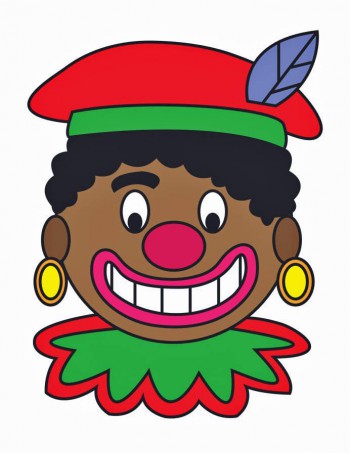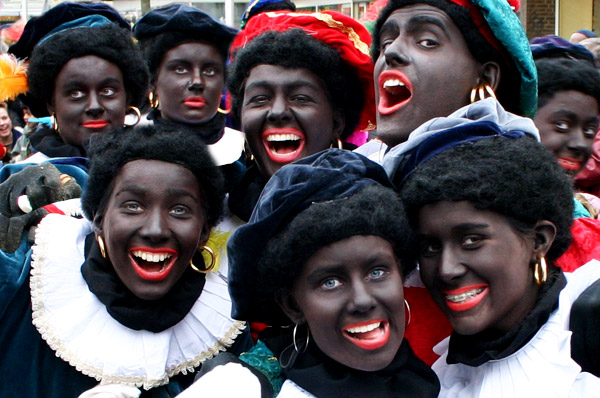‘Black Pete’: The Dutch Tradition Continues to Polarize a Nation
By Mitchell Esajas, President of the New Urban Collective in the Netherlands, a member organisation of the European Network Against Racism (ENAR)
Tradition and fundamental rights will continue to clash.
Over the last couple of years a fierce debate has emerged in the Netherlands about a controversial tradition, ‘Black Pete’ (Zwarte Piet in Dutch), a central figure in the Saint Nicholas festivities, an annual gift-giving celebration in December.
While many Dutch people see the tradition as an “innocent” children’s holiday involving the public festivities and the exchange of gifts, candy and cookies, an increasing amount of people, however, see the tradition as offensive and a caricature of black people. In contrast to Saint Nicolas celebrations in Germany and other European countries, the saint is accompanied by the mythic figure Black Pete. Black Pete is often played by white people wearing black-face makeup, big red lips and a wig of frizzy black hair and shops sell the same caricatured candies, dolls, etc. They play their role as the subservient, unintelligent, childish and clownish caricature helping the old, wise and kind white Saint to carry out the work.
Last year an advisor to the UN High Commissioner of Human Rights, Verene Shepherd, wrote: “The character and image of Black Pete perpetuate a stereotyped image of African people and people of African descent as second-class citizens, fostering an underlying sense of inferiority within Dutch society and stirring racial differences as well as racism.” Opponents see the Black Pete figure as a symbol of systemic and structural forms of racism and discrimination rooted in the Dutch colonial past.
Despite the Netherlands’ reputation for tolerance and progressive policies, the Council of Europe’s Commission Against Racism and Intolerance recently expressed concerns about racism and racial discrimination against Black people and other people of colour in the country, in education, the labour market and other areas. Reports by the European Network Against Racism also show that racism and discrimination continue to reproduce structural inequalities. Racism, however, is a taboo subject in Dutch society and is played down by the Dutch government and society in general. This makes the Black Pete debate a controversial issue which politicians would rather ignore.
There has been opposition to the controversial figure Black Pete for decades. But the anti-Black Pete movement gained momentum in 2013 after 21 people including activists, intellectuals and youth from different cultural and social backgrounds filed a law suit against the city of Amsterdam for granting a permit to the annual Saint Nicolas parade which includes the racist stereotypical figure Black Pete. In July 2014, the court of Amsterdam ruled that Black Pete is indeed a negative stereotype of black people, based on statistical information, a statement from the Dutch Institute of Human Rights and the Convention for the Protection of Human Rights and Fundamental Freedoms. The court ordered the municipality to re-examine its decision to grant a permit to the Saint Nicholas festivities but the Mayor of Amsterdam and an organisation of Black Pete performers decided to lodge an appeal against the ruling.

On 12 November 2014 the Council of State, the highest administrative court in the Netherlands, overturned the lower court’s decision stating that the mayor is not authorised to judge the content of festivities in the process of granting a permit. According to the Council, the mayor is only obliged to judge whether public order and safety are at stake, not if stigmatisation, unequal treatment and discrimination may occur. The ruling of the Council of State was disappointing as it reflected the bias of the Council to rule in favour of the Dutch State.
On 15 November, Saint Nicolas and his Black Petes were welcomed by a national fanfare and parade in Gouda. A non-violent silent protest was planned on this day, however the mayor of Gouda prohibited the protest at the site of the festivities, ordering people to demonstrate outside of the inner city, far from the parade.
Protesters nevertheless decided to go ahead with the non-violent silent protest and to exercise their fundamental right to freedom of expression and freedom of peaceful assembly. More than 80 people were arrested by the police, in one case violently. The protesters were released after a few hours of imprisonment and announced that they would continue to demonstrate until Black Pete becomes history.
The tradition has sparked a debate about racism but also about cultural diversity in a multicultural society, identity and citizenship. These are issues which black people and other migrant communities and European countries face as well. This weekend’s protests highlight the fact that Dutch institutions continue to struggle with the legacy of the country’s colonial past by maintaining the controversial tradition and disregarding the hurt caused to millions of Dutch citizens and residents of African descent. Tradition and fundamental rights will continue to clash as long as politicians and institutions do not take leadership to face the Dutch society’s problem with racism and discrimination.




Right or wrong, leave people and their culture alone.
Alternatively: “Right or wrong, speak your truth”. Maybe your voice / your opinion will create change.